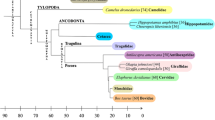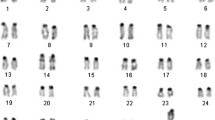Abstract
The laboratory mouse (Mus musculus, 2n = 40), the Chinese hamster (Cricetulus griseus, 2n = 22), and the golden (Syrian) hamster (Mesocricetus auratus, 2n = 44) are common laboratory animals, extensively used in biomedical research. In contrast with the mouse genome, which was sequenced and well characterized, the hamster species has been set aside. We constructed a chromosome paint set for the golden hamster, which for the first time allowed us to perform multidirectional chromosome painting between the golden hamster and the mouse and between the two species of hamster. From these data we constructed a detailed comparative chromosome map of the laboratory mouse and the two hamster species. The golden hamster painting probes revealed 25 autosomal segments in the Chinese hamster and 43 in the mouse. Using the Chinese hamster probes, 23 conserved segments were found in the golden hamster karyotype. The mouse probes revealed 42 conserved autosomal segments in the golden hamster karyotype. The two largest chromosomes of the Chinese hamster (1 and 2) are homologous to seven and five chromosomes of the golden hamster, respectively. The golden hamster karyotype can be transformed into the Chinese hamster karyotype by 15 fusions and 3 fissions. Previous reconstructions of the ancestral murid karyotype proposed diploid numbers from 2n = 52 to 2n = 54. By integrating the new multidirectional chromosome painting data presented here with previous comparative genomics data, we can propose that syntenies to mouse Chrs 6 and 16 were both present and to hypothesize a diploid number of 2n = 48 for the ancestral Murinae/Cricetinae karyotype.







Similar content being viewed by others
References
Cavagna P, Stone G, Stanyon R (2002) Black rat (Rattus rattus) genomic variability characterized by chromosome painting. Mamm Genome 13, 157–163
Dawson WD, Young SR, Wang Z, Liu LW, Greenbaum IF, et al. (1999) Mus and Peromyscus chromosome homology established by FISH with three mouse paint probes. Mamm Genome 10, 730–733
Engelbrecht A, Dobigny G, Robinson TJ (2006) Further insights into the ancestral murine karyotype: the contribution of the Otomys-Mus comparison using chromosome painting. Cytogenet Genome Res 112, 126–130
Ferguson-Smith MA (1997) Genetic analysis by chromosome sorting and painting: phylogenetic and diagnostic applications. Eur J Human Genet 5, 253–265
Gamperl R, Vistorin G, Rosenkranz W (1978) Comparison of chromosome banding patterns in five members of Cricetinae with comments on possible relationships. Caryologia 31, 343–353
Graphodatsky AS (1989) Conserved and variable elements of mammalian chromosomes. In Cytogenetics of Animals, Halnan C, (ed.) (Oxon: CAB International Press), pp 95–123
Graphodatsky AS, Sablina OV, Meyer MN, Malikov VG, Isakova EA, et al. (2000) Comparative cytogenetics of hamsters of the genus Calomyscus. Cytogenet Cell Genet 88, 296–304
Graphodatsky AS, Yang F, O’Brien PC, Perelman P, Milne BS., et al. (2001) Phylogenetic implications of the 38 putative ancestral chromosome segments for four canid species. Cytogenet Cell Genet 92, 243–247
Guilly M-N, Fouchet P, de Chamisso P, Schmitz A, Dutrillaux B (1999) Comparative karyotype of rat and mouse using bidirectional chromosome painting. Chromosome Res 7, 213–221
Guilly M-N, Dano L, de Chamisso P, Fouchet P, Dutrillaux B, et al. (2001) Comparative karyotype using bidirectional chromosome painting: how and why? Meth Cell Sci 23, 163–170
Li S, Pathak S, Hsu TC (1982) High resolution G-banding patterns of Syrian hamster chromosomes. Cytogenet Cell Genet 33, 295–302
Matsubara K, Nishida-Umehara C, Kuroiwa A, Tsuchiya K, Matsuda Y (2003) Identification of chromosome rearrangements between the laboratory mouse (Mus musculus) and the Indian spiny mouse (Mus platythrix) by comparative FISH analysis. Chromosome Res 11, 57–64
Matsubara K, Nishida-Umehara C, Tsuchiya K, Nukaya D, Matsuda Y (2004) Karyotypic evolution of Apodemus (Muridae, Rodentia) inferred from comparative FISH analyses. Chromosome Res 12, 383–395
Murphy WJ, Stanyon R, O’Brien SJ (2001) Evolution of mammalian genome organization inferred from comparative gene mapping. Genome Biol 2(6), 1–8
Murphy WJ, Larkin DM, Evert-van der Wind A, Bourque G, Tesler G, et al. (2005) Dynamics of mammalian chromosome evolution inferred from multispecies comparative maps. Science 309, 613–617
Pavia RA, Smith LW, Goldenberg DM (1977) An analysis of the G-banded chromosomes of the golden hamster. Int J Cancer 20, 460–465
Popescu NC, DiPaolo JA (1972) Identification of Syrian hamster chromosomes by acetic-saline-Giemsa (ASG) and trypsin techniques. Cytogentics 11, 500–507
Radjabli SI, Sablina OV, Graphodatsky AS (2006) Selected karyotypes. In ATLAS of Mammalian Karyotypes, O’Brien SJ, Nash WG, Menninger JC, (eds.) (New York: John Wiley & Sons), pp 305, 329–352
Rambau RV, Robinson TJ (2003) Chromosome painting in the African four-striped mouse Rhabdomys pumilio: detection of possible murid specific contiguous segment combination. Chromosome Res 11, 91–98
Scherthan H, Cremer T, Arnason U, Weier HU, Lima-de-Faria A, et al. (1994) Comparative chromosome painting discloses homologous segments in distantly related mammals. Nat Genet 6(4), 342–347
Seabright M (1971) A rapid banding technique for human chromosomes. Lancet 2, 971–972
Stanyon R, Yang F, Cavagna P, O’Brien PC, Bagga M, et al. (1999) Reciprocal chromosome painting shows that genomic rearrangement between rat and mouse proceeds ten times faster than between humans and cats. Cytogenet Cell Genet 84(3–4), 150–155
Stanyon R, Yang F, Morescalchi AM, Galleni L (2004) Chromosome painting in the long-tailed field mouse provides insights into the ancestral murid karyotype. Cytogenet Genome Res 105, 406–411
Steppan S, Adkins R, Anderson J (2004) Phylogeny and divergence-data estimates of rapid radiations in muroid rodents based on multiple nuclear genes. Syst Biol 53(4), 533–553
Telenius H, Pelmear AH, Tunnacliffe A, Carter NP, Behmel A, et al. (1992) Cytogenetic analysis by chromosome painting using DOP-PCR amplified flow-sorted chromosomes. Genes Chromosomes Cancer 4, 226–257
Trifonov VA, Perelman PL, Kawada SI, Iwasa MA, Oda SI, et al. (2002) Complex structure of B-chromosomes in two mammalian species: Apodemus peninsulae (Rodentia) and Nyctereutes procyonoides (Carnivora) revealed by microdissection. Chromosome Res 10(2), 109–116
Waterston RH, Lindblad-Toh K, Birney E, Rogers J, Abril JF, et al. (2002) Initial sequencing and comparative analysis of the mouse genome. Nature 420, 520–562
Yang F, Carter NP, Shi, Ferguson-Smith MA (1995) A comparative study of karyotypes of muntjacs by chromosome painting. Chromosoma 103, 642–652
Yang F, O’Brien PC, Milne BS, Graphodatsky AS, Solanky N, et al. (1999) A complete comparative chromosome map for the dog, red fox, and human and its integration with canine genetic maps. Genomics 62, 189–202
Yang F, O’Brien PC, Ferguson-Smith MA (2000) Comparative chromosome map of the laboratory mouse and Chinese hamster defined by reciprocal chromosome painting. Chromosome Res 8, 219–227
Acknowledgments
This study was funded in part by Molecular and Cell Biology (MCB), Russian Fund for Basic Research (RFBR), Biosphere Origin and Evolution (BOE), Dynamics of Genofonds of Plants, Animals and Human (DGPAH) research grants (ASG), an INTAS Grant to ASG and MAF-S, and a Wellcome trust grant to MAF-S. RS and PLP thank Gary Stone for additional flow sorting. RS was previously at NCI-Frederick and was partially supported by a grant from MIUR (Ministero Italiano della Universita’ e della Ricerca), “Mobility of Italian and Foreign Researchers Residing Abroad.”
Author information
Authors and Affiliations
Corresponding author
Rights and permissions
About this article
Cite this article
Romanenko, S.A., Perelman, P.L., Serdukova, N.A. et al. Reciprocal chromosome painting between three laboratory rodent species. Mamm Genome 17, 1183–1192 (2006). https://doi.org/10.1007/s00335-006-0081-z
Received:
Accepted:
Published:
Issue Date:
DOI: https://doi.org/10.1007/s00335-006-0081-z




